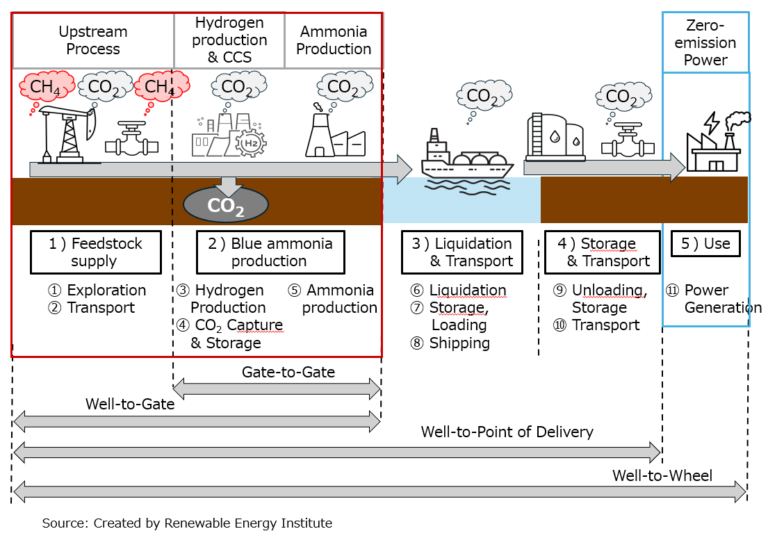The Renewable Energy Institute has published a new column in their “Key Issues to Address in Japan’s Strategic Energy Plan” series, titled “How Much Emission Will Japan’s “Zero Emission Thermal Power” Emit?”
The Japanese government is advancing the development of ammonia and hydrogen as decarbonized fuels, highlighted by the enactment of the Hydrogen Society Promotion Act in May 2024. Under this policy, major electric power companies have outlined a decarbonization roadmap involving ammonia co-firing in coal-fired power plants, which they refer to as “zero-emission” thermal power. These companies are actively conducting demonstration tests, developing turbines, and establishing supply chains. However, can Japan’s coal-fired power plants that utilize ammonia co-firing be considered “abated” by the international community?
The column explains Japan’s carbon intensity standard for hydrogen and hydrogen-based fuels, including ammonia, using a coal-fired ammonia co-firing project as an example. The Renewable Energy Institute points out that, along with emissions associated with the long-distance import process, the calculation scope of the Japanese government’s standard might also not account for upstream emissions in ammonia supply chains.
According to the standard proposed by the Ministry of Economy, Trade and Industry (METI) for ammonia co-firing, approximately 88% of the greenhouse gas emissions from a conventional coal-fired power plant would remain with 20% co-firing, around 69% with 50% co-firing, and about 38% even with 100% ammonia firing. Moreover, this comparison does not consider emissions from the transport of ammonia fuel. Calculations based on the Japanese government’s emission standards for low-carbon hydrogen indicate that the emissions from ammonia co-firing or 100% ammonia firing in coal-fired power plants are not low enough to be considered “abated.” This suggests that Japan’s carbon intensity standards do not align with international criteria for “abatement.” Regardless of whether gray (fossil fuel-produced) or blue (fossil fuel-produced with emissions captured using CCS) ammonia is utilized, greenhouse gases are emitted during upstream processes and transportation, including the extraction of fuels such as natural gas. Japan’s continued reliance on fuel imports raises concerns about energy security and the cost of ammonia fuel, which is likely to be significantly higher than coal. Additionally, the government plans to subsidize companies for the price difference when using more expensive ammonia, raising questions on the potential use of taxpayer money to support this price disparity for what it does not contribute to energy security.
At the G7 Climate, Energy, and Environment Ministers’ summit held in Italy in June 2024, G7 countries agreed to phase out unabated coal-fired power in the first half of the 2030s. Despite Japan’s assertion that ammonia co-firing can be considered an emission reduction measure and, therefore, “abatement,” it does not meet internationally recognized standards for abatement or the global carbon neutrality goal.
The Japanese government is not only promoting “zero-emission thermal power” domestically but also advocating for the export of related technologies to countries throughout Asia. When discussing “zero-emission thermal power,” it is crucial to consider the emissions from the “non-zero emission” aspects.
Renewable Energy Institute
[Column Series] Key Issues to Address in Japan’s Strategic Energy Plan (No.8)
How Much Emission Will Japan’s “Zero Emission Thermal Power” Emit?
With Proposed Low-carbon Hydrogen and Ammonia Standards, Coal Remains “Unabated”
(Link)

